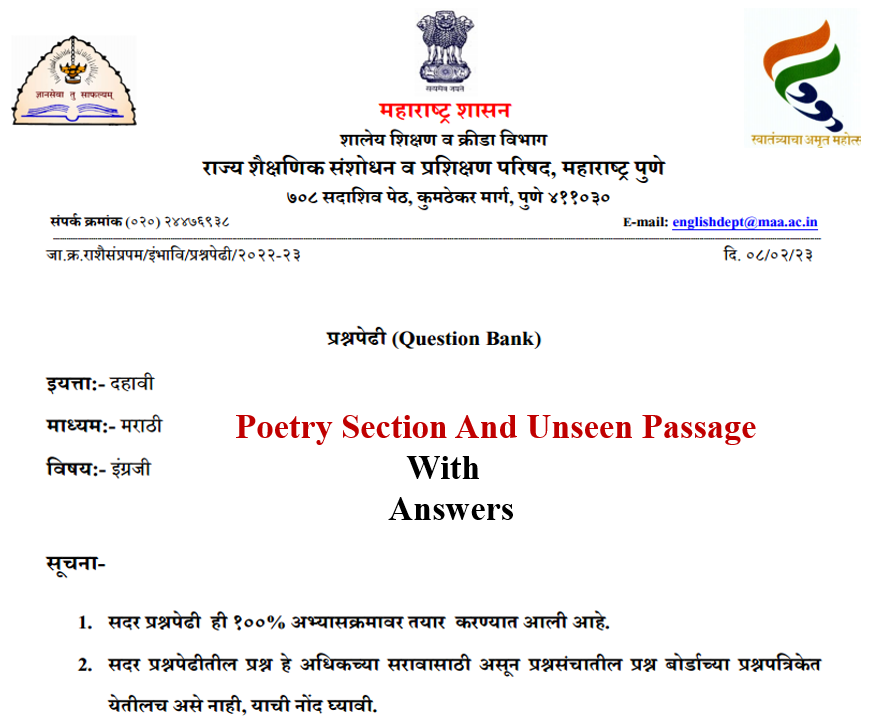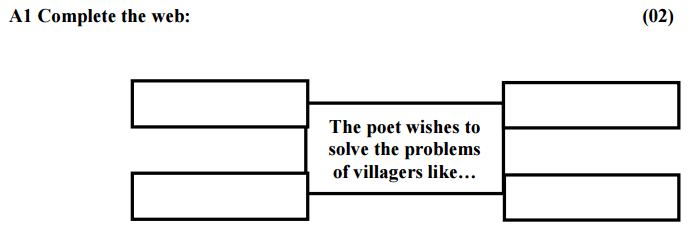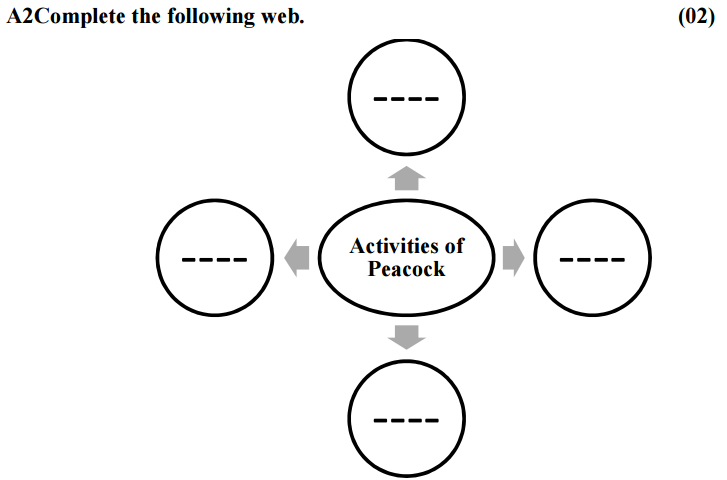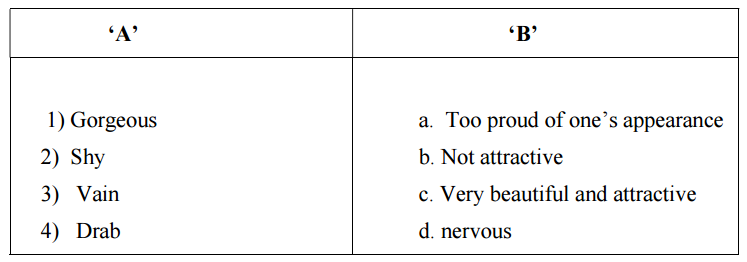

SSC Question Bank Poetry Section & Unseen Passage With Answers
Q.3 (A) Read the following extract and do the given activities. (5 Marks)
A Teenager’s Prayer
Each day brings new beginnings,
Decisions I must make.
I am the only one to choose
The road that I will take.
I can choose to take the road of life,
That leads to great success
Or travel down the darkened road,
That leads to great distress.
Please open up my eyes, dear Lord,
That I might clearly see Help me stand for what is right,
Bring out the best in me. Help,
Lord, to just say “no” When temptation comes my way,
That I might keep my body clean
And fit for life each day.
When my teenage years are over,
I know that I will see
That life is lived its very best
With you walking next to me.
– J. Morse

Ans:
- Guidance to make the right decisions and choose the correct path.
- The ability to see clearly and stand for what is right.
- Strength to resist temptation and keep themselves pure.
- The assurance of God’s presence throughout their life, especially after their teenage years.
A2 Complete the given lines: (02)
a) Help me _____________
b) That I might ____________
Ans:
- Help me stand for what is right,”
- “That I might keep my body clean,”
A3 Write at least two pairs of rhyming words from the poem. (01)
Ans:
- Make: take
- Clean: seen
Q.3 B Appreciation of the poem. (5 Marks)
Read the poem ‘Teenagers Prayer’ and write an appreciation of it with the help of the given
points:
1. Title
2. Poet
3. Figure of speech
4. Rhyme Scheme
5. Central idea. Ans:
1. Title :- The title of the poem is ‘A Teenagers Prayer’
2. Poet :- The poem is written by ‘J Morse’
3. Rhyme Scheme :- The rhyme schme of the poem is ‘abcb’
4. Figures of speech: – The figure of speech in the poem:-
i) Apostrophe – ex. Please open up my eyes dear lord,
ii) Alliteration – ex. Travel down the darkened road.
5. Theme/ Central Idea: – The teenager age is very important in person’s life because in that time person decides the path of future. If the person choose right path then he will be successful & If he will choose wrong path then the person will fail. So the teenager age is asking to show the right path to the god to create positivity,
Q.3 (A) Read the following extract and do the given activities. (5 Marks)
Basketful of Moonlight
O moon,
give me moonlight,
basketful or two baskets full,
with seeds of moonlight.
From the city to my village,
on the sides of the path
I want to sow many,
small, small moons of light.
The whole village goes to the city
daily to work.
It becomes dark on its way back
as my village is quite far.
The route is tough and full of
snakes and scorpions.
Neither bus nor cart plies.
When my father returns home
I am asleep.
And he goes back early in the morning
while I am sleeping.
O moon
give me a basketful of moonlight
on loan.
I want to light the dark route
so that my father returns early.
I too want to hear fairy tales
and stories from him.
O moon,
give me a basketful of moonlight.
I want to sow seeds of moon
on the sides of the path.
– Sunil Sharma (Translated from Dogri)

Ans:
- Darkness on rural paths.
- Dangerous wildlife on the route.
- Lack of public transportation.
- Limited family time due to work hours.
A2 State whether the following statements are true or false. (02)
a) There are many buses to return for the villages.
b) It is very dark on its way back to the village.
c) The poet wants his father to return early.
d) The poet wants to play with his father on his return.
Ans:
a) False.
b) True.
c) True..
d) False.
A3 Name the figures of speech in the given lines: (01)
a) I want to sow many small, small, moons of light.
b) I want to sow seeds of moon on the sides of path. Ans:
a) Alliteration, Repetition
b) Metaphor
Q.3 B Appreciation of the poem
Read the poem ‘Basketful of Moonlight’ and write an appreciation of it with the help of the
given points:
1. Title
2. Poet
3. Figure of speech
4. Rhyme Scheme
5. Central idea. Ans:
1.3 Basketful of moonlight
1. Title: – The title of the poem is ‘Basketful of moonlight’
2. Poet: – The poem is written by ‘Sunil Sharma’
3. Rhyme Scheme: – There is no rhyme shceme. The Poem is Free Verse
4. 6. Figure of speech:- The figure of speech is:
i. Alliteration:- ex. The route is tough & full of snakes & scorpions.
ii. Repetition: – Small Small moons of light.
iii. Antithesis: – I want to light the dark route
5. Central Idea:- The central idea of the poem is this poem is request of a child
to the moon the child requests it to gave him one or two basketful
of seeds of moonlight He wishes to saw the small moons of light
from city to his village & enlighten the road. Poet describes village
life is full of dangers & he shows love for his father.
Q.3 (A) Read the following extract and do the given activities. (5 Marks)
You Start Dying Slowly
If you do not travel,
If you do not read,
If you do not listen to the sounds of life,
If you do not appreciate yourself.
You start dying slowly…
When you kill your self-esteem;
When you do not let others help you.
You start dying slowly…
If you become a slave of your habits,
Walking everyday on the same paths…
If you do not change your routine,
If you do not wear different colours
Or you do not speak to those you don’t know.
You start dying slowly…
If you avoid to feel passion
And their turbulent emotions;
Those which make your eyes glisten
And your heart beat fast.
You start dying slowly…
If you do not change your life when you are not satisfied with your job,
or with your love,
If you do not risk what is safe,
for the uncertain,
If you do not go after a dream,
If you do not allow yourself,
At least once in your lifetime,
To run away from sensible advice…
– Pablo Neruda 
Ans:
- Not traveling
- Not reading
- Not listening to the sounds of life
- Not appreciating yourself
- Killing your self-esteem
- Not letting others help you
- Becoming a slave of your habits
- Walking every day on the same paths
- Not changing your routine
- Not wearing different colors
A2 Fill in the describing words in the space given: (02) i) __________advice
ii) _________emotions
iii) ___________paths
iv) ___________colours
Ans:
i) Sensible advice
ii) Turbulent emotions
iii) Same paths
iv) Different colours
A3. Pick out a line from the poem and write down with a figure of speech it describes. (1)
Ans:
“You start dying slowly…” – This line uses repetition as a figure of speech.
Q.3 B Appreciation of the poem. (5 Marks)
Read the poem ‘You start Dying Slowly’ and write an appreciation of it with the help of the
given points:
1. Title
2. Poet
3. Figure of speech
4. Rhyme Scheme
5. Central Idea
Ans:
2.1 You Start Dying Slowly …
1. Title :- The title of the poem is ‘You Start Dying Slowly …’
2. Poet : – The poem is written is ‘Pablo Neruda’
3. Rhyme Scheme : – There is no rhyme scheme. Poem is Free Verse.
4. Figure of speech: – Repetition, Metaphor, Anthesis
5. Theme / Central Idea: – The poet is telling us to do new things every day and avoid negative thoughts and always be positive. We should enjoy each and every moment of our life. Trust yourself and love what you do.
Q.3 (A) Read the following extract and do the given activities.
The Twins
In form and feature, face and limb,
I grew so like my brother,
That folks got taking me for him,
And each for one another.
It puzzled all our kith and kin,
It reached a fearful pitch;
For one of us was born a twin,
Yet not a soul knew which.
One day, to make the matter worse,
Before our names were fixed,
As we were being washed by nurse,
We got completely mixed;
And thus, you see, by fate’s decree,
Or rather nurse’s whim,
My brother John got christened me,
And I got christened him.
This fatal likeness even dogged
My footsteps, when at school,
And I was always getting flogged,
For John turned out a fool.
I put this question, fruitlessly,
To everyone I knew,
‘What would you do, if you were me,
To prove that you, were you?’
Our close resemblance turned the tide
Of my domestic life,
For somehow, my intended bride
Became my brother’s wife.
In fact, year after year the same
Absurd mistakes went on,
And when I died, the neighbours came
And buried brother John.
– Henry Sambrooke Leigh
A1 Complete the following: (02)
a) The twins were similar to each other in _______and ________.
b) The main characters in the poem are ___________and ________.
Ans:
a) The twins were similar to each other in form and feature, face and limb.
b) The main characters in the poem are the narrator and his brother John.

Ans:
- They were so alike that even their kith and kin were puzzled, and they could not tell the twins apart.
- They got completely mixed up by the nurse before their names were fixed, leading to the wrong twin being christened with the other’s name.
A3 Identify the figure of speech mentioned in the given lines. (Anyone) (01)
a) As we were being watched by nurse.
b) For one of us was born a twin. Ans:
a) hyperbole
b) paradox/ pun
Q.3(B) Appreciation of the poem: (5 Marks)
Read the poem ‘The Twins’ and write an appreciation of it with the help of the given points:
1. Title
2. Poet
3. Figure of speech
4. Rhyme Scheme
5. Central Idea
Ans:
2.3 The Twins
1. Title :- The title of the poem is ‘The Twins’
2. Poet : – The poem is written is ‘Henry Sambrooke Leigh’
3. Rhyme Scheme : – The rhyme scheme of the poem is ‘ababcdcd’
6. Figure of speech:- There are three figures of speech in the poem.
Alliteration, Pun & hyperbole.
Example: – Alliteration: – In form & feature, face & limb
5. Theme / Central Idea: – This is a humorous poem. The poet & his brother are twins so there life became humorous & trouble same in various ways they faced many problems & the problems are so exaggerated. by the poet to make humorous but we trusted it for brief time.
Q.3 (A) Read the following extract and do the given activities. (5 Marks)
If …
If you can keep your head when all about you
Are losing theirs and blaming it on you;
If you can trust yourself when all men doubt you,
But make allowance for their doubting too;
If you can wait and not be tired by waiting,
Or, being lied about, don’t deal in lies,
Or being hated, don’t give way to hating,
And yet don’t look too good, nor talk too wise:
If you can dream and not make dreams your master;
If you can think and not make thoughts, your aim;
If you can meet with Triumph and Disaster
And treat those two imposters just the same;
If you can bear to hear the truth, you’ve spoken,
Twisted by knaves to make a trap for fools,
Or watch the things you gave your life to, broken,
And stoop and build ’em up with worn-out tools:
If you can talk with crowds and keep your virtue,
Or walk with Kings, nor lose the common touch;
If neither foes nor loving friends can hurt you,
If all men count with you, but none too much;
If you can fill the unforgiving minute
With sixty seconds’ worth of distance run,
Yours is the Earth and everything that’s in it,
And which is more you’ll be a Man, my son
– Rudyard Kipling
A1 Complete the following: (02)
a. If you can force your heart and nerve and sinew ______________________
b. If you can fill the unforgiving minute _______________________________
Ans:
- If you can force your heart and nerve and sinew to serve your turn long after they are gone, And so hold on when there is nothing in you Except the Will which says to them:
- If you can fill the unforgiving minute With sixty seconds’ worth of distance run, Yours is the Earth and everything that’s in it, And which is more you’ll be a Man, my son.

Ans:
a. virtue – behaviour displaying high moral standards.
b. foe – enemy
A3. Pick out a line that indicates personification. (01)
Ans:
“If you can meet with Triumph and Disaster,
And treat those two imposters just the same;”
Q.3 B Appreciation of the poem. (5 Marks)
Read the above poem ‘If……’ and write an appreciation of it with the help of the given
points:
1. Title
2. Poet
3. Figure of speech
4. Rhyme Scheme
5. Central Idea
Ans:
3.1 “ If”
1. Title: – The title of the poem is ‘If’
2. Poet: – The poem is written by ‘Rudyard Kipling’
3. Rhyme Scheme: – In first Stanza is ‘aaaa’ & remaining Stanza is ‘abab.’
4. Figures of speech: – There is personification
ex: – If you can meet with triumph & disaster
6. Theme / Central Idea: – The poet gives many advice to us. He also advice
us what is important in our life. The highest quality described here that we should treat people then we will be a man if we use time properly. We should be the master of this earth, ‘If we follow all this advice then we can live happily.
Q.3 (A) Read the following extract and do the given activities. (5 Marks)
Stopping by Woods on a Snowy Evening
Whose woods these are I think I know.
His house is in the village though;
He will not see me stopping here
To watch his woods fill up with snow.
My little horse must think it queer
To stop without a farmhouse near
Between the woods and frozen lake
The darkest evening of the year.
He gives his harness bells a shake
To ask if there is some mistake.
The only other sound’s the sweep
Of easy wind and downy flake.
The woods are lovely, dark and deep,
But I have promises to keep,
And miles to go before I sleep,
And miles to go before I sleep.
Robert Frost
A1 Complete the following: (02)
a. He will not see me stopping here _______________________________
b. He gives his harness bells a shake _______________________________
Ans:
a. He will not see me stopping here to watch his woods fill up with snow. b. He gives his harness bells a shake to ask if there is some mistake.
A2 Explain the line: ‘But I have promises to keep.’ (02)
Ans:
This line from Robert Frost’s poem shows the speaker feeling a strong sense of duty. Even though the quiet, snowy woods are tempting and beautiful, he remembers he has important things to do. “Promises to keep” means he has important responsibilities that can’t be ignored, even if he wants to take a break. It’s about choosing to do what we must over what we want, showing how we often have to balance enjoying peaceful moments with meeting our obligations.
Top of Form
A3 Fill in with the rhyming words: (01)
- here – ________ b. shake – _______
Ans:
- here – near b. shake – mistake
Q.3 B Appreciation of the poem. (5 Marks)
Read the poem ‘Stopping by Woods on a Snowy Evening’ and write an appreciation of it with the help of the given points:
1. Title
2. Poet
3. Figure of speech
4. Rhyme Scheme
5. Central Idea
Ans:
3.3 Stopping by Woods on a Snowy Evening
1. Title :- The title of the poem is ‘Stopping by Woods on a Snowy Evening’
2. Poet : – The poem is written by ‘Robert Frost’
3. Rhyme Scheme: – In first three stanzas- ‘aaba’ and in last stanza ‘aaaa’
4. Figure of speech: – i. imagery, personification, metaphor etc.
ii. Inversion. Ex. Whose woods there are I think I know.
5. Theme / Central Idea: – In this poem the poet describes a little incident happening in a snowy evening as a traveller, the poet fascinated by the beautiful scenes in the woods. He wanted to stop there and enjoy the beauty of the place but had to keep travelling to reach his destination.
Q.3 (A) Read the following extract and do the given activities. (5)
The World is Mine (Extract 1)
Today on a bus, I saw a lovely girl with silken hair
I envied her, she seemed so gay, and I wished I was so fair
When suddenly she rose to leave, I saw her hobble down the aisle
She had one leg and wore a crutch, but as she passed –a smile
O God forgive me when I whine
I have two legs,the world is mine
And then I stopped to buy some sweets, The lad who sold them had such charm
I talked with him , he seemed so calm ,and if I were late, it would do no harm,
And as I left he said to me “I thank you, you have been so kind”
It’s nice to talk with folks like you. You see, I’m blind
O God forgive me when I whine
I have two eyes, the world is mine
A1 Complete the following: (02)
a. When suddenly she rose to leave,________________
b. I have two legs,_______________
Ans:
a. When suddenly she rose to leave, I saw her hobble down the aisle.
b. I have two legs, the world is mine.
A2 Write the describing words attributed to: (02)
_____ whine
______eyes
Ans:
- envied whine
- silken eyes
A3 Pick out a line from the extract which conveys a strong Imagery. (01)
Ans:
“Today on a bus, I saw a lovely girl with silken hair.”
The World is Mine (Extract 2)
Later walking down the street, I saw a child with eyes of blue
He stood and watched the others play; it seemed he knew not what to do
I stopped a moment, then I said, why don’t you join the others dear”
He looked ahead without a word, and then I knew he could not hear
O God forgive me then I whine
I have two ears, the world is mine
With legs to take me where I’ll go
With eyes to see the sunset’s glow
With ears to hear what I would know
O God forgive me when I whine
I’m blessed; indeed, the world is mine
Q.3 (A) Read the following extract and do the given activities. (5)
A1 Complete the following: (02)
a. He stood and watched the other play, it___________________
b. He looked ahead without a word, And________________________
Ans:
a. He stood and watched the others play, it seemed he knew not what to do.
b. He looked ahead without a word, and then I knew he could not hear.
A2 What do you understand when the poet says, “The world is Mine”. (02)
Ans:
When the poet says “The world is Mine,” they mean they’re really thankful for simple things like hearing, seeing, and walking. These things let them enjoy life and the world. They realize how special these abilities are, especially after seeing a child who can’t hear. This makes the poet feel lucky and reminds them to be grateful for what they have.
A3 Pick out an example of imagery from the stanza. (01)
Ans:
An example of imagery from the stanza is “With eyes to see the sunset’s glow.”
Q.3B Appreciation of the poem. (5 Marks)
Read the given poem ‘The World is Mine’ and write an appreciation
of it with the help of the given points:
1. Title
2. Poet
3. Figure of speech
4. Rhyme Scheme
5. Central Idea Ans:
4.1 The World is Mine
1. Title :- The title of the poem is ‘The World is Mine’
2. Poet :- The poem iswritten by ‘Joy Lovelet Crawford’
3. Rhyme Scheme :- The figure of the poem is:
1st Stanza – aabcc, 2nd Stanza – abbccdd
3rd Stanza – aabbcc 4th Stanza – aaabb
6) Figure of Speech :- There are many figure of speech given in the poem:-
Inversion , Interrogation, onomatopoeia, Apostrophe, etc
Inversion :- ex – Today on a bus, I saw a girl
5. Theme/Central Idea:- The poem is a Combination of serious tragedy & of gratitude to wards God in this poem the poet expressed her fillings
gratitude. Love & asked to God forgive her as she is complaining.
SECTION IV: NON-TEXTUAL PASSAGE
SET 4: Q. 4UNSEEN PASSAGES (15 Marks)
Q.4 A Read the following passage and do the activities. (10 Marks)
A1State the following statements True or false. (02)
1) Pink City Jaipur was declared as World Heritage site by UNESCO.
2) The decision to declare Jaipur a WHC was taken at Kazakhstan.
Ans:
True –
False –
|
Pink City Jaipur was declared a World Heritage site by UNESCO. The decision was taken at the 43rd session of the UNESCO World Heritage Committee (WHC) in the historic cityof Baku, Azerbaijan from June 30-July 2010. The fortified city of Jaipur, in India’s northwestern state of Rajastan was founded in 1727 by Sawai jai Singh II. The walled city of Jaipur, known for its iconic architectural legacy and vibrant culture, made its entry into the UNESCO World Heritage site list, becoming the second city in the country after Ahmedabad. India had proposed the notification of Jaipur as an exceptional urban example in indigenous city planning, the Ministry of Culture said in a statement. “Besides exemplary planning its iconic monuments such as the Govind Dev Temple, City Palace, Jantar Mantar, and Hawa Mahal excel in artistic and architectural craftsmanship of the period.” UNESCO seeks to encourage the identification, protection and prevention of cultural and natural heritage around the world considered to be the outstanding value of humanity. |
A2. Complete the following sentences: (02)
i) The fortified city of Jaipur was founded by ____________ in___________.
ii) The city of Jaipur is known for its ___________ and _____________
Ans:
i) The fortified city of Jaipur was founded by Sawai Jai Singh II in 1727.
ii) The city of Jaipur is known for its iconic architectural legacy and vibrant culture.

Ans:
- UNESCO
- Cultural Heritage
- Jaipur
- Architecture
- Preservation
A4. Do as directed (02)
i) It is ideal for day trips. (Choose the correct question tag)
a) Is it?
b) Was it?
c) Isn’t it?
d) Wasn’t it?
Ans:
c) Isn’t it?
ii) UNESCO seeks to encourage the prevention of cultural and natural heritage.
(Rewrite the sentence using ‘not only ……but also’)
Ans:
UNESCO seeks not only to encourage the prevention of cultural heritage but also natural heritage.
A5Personal Response (02)
Describe a historical place which you visited recently.
Q.4 B. Summary Writing. (5Marks)
Read the passage given in Q4Aand write the summary of it.
Suggest a suitable title.
Ans:
Title: “Jaipur: A UNESCO World Heritage City”
Summary:
Jaipur, known as the Pink City, is now a UNESCO World Heritage Site. The decision was made in Baku, Azerbaijan, in 2010. Founded in 1727 by a ruler named Sawai Jai Singh II, Jaipur is famous for its beautiful buildings and culture. It’s the second Indian city to get this title after Ahmedabad. UNESCO aims to protect special places like Jaipur for the whole world to value.
Q.4ARead the following passage and do the activities. (10 Marks)
A1Complete the following sentences. (02)
a) Peacocks shed their tail feathers once………….
b) The peacock is our………………
c) The peacock, although a shy bird, dances……………..
d) The peacocks have a special place in our arts, songs,…………..
Ans:
a) Peacocks shed their tail feathers once a year.
b) The peacock is our national bird.
c) The peacock, although a shy bird, dances during courtship and to celebrate rain clouds.
d) The peacocks have a special place in our arts, songs, dances, and culture.
|
The peacock is perhaps the most beautiful among male birds, with its long blue neck. Fan-shaped crest, and its gorgeous train or tail of feathers. Each feather ends in a half-moon or ‘eye’. When raised, the tail spreads like a fan from which a thousand eyes seem to gaze. Ironically the female or peahen is a small, drab bird in comparison, without the sweeping train. Peacocks shed their tail feathers once a year and grow new ones. People carefully these old feathers, which are then made into lovely fans and other decorative items. The peacock, although a shy bird, dances in front of the peahens during courtship. He then struts before them showing off his many-coloured train. The sight of rain clouds is another occasion for such display, perhaps to hail the arrival of rain after the long hot summer. The peacock’s loudly strutting has also given rise to the commonly used phrases, proud as a peacock’ and ‘as vain as a peacock. The peacock is our national bird. The peacocks have a special place in our arts, songs, dances, culture and stories. |

Ans:
- Shedding Tail Feathers
- Courtship Dance
- Celebrating Rain
- Featuring in Arts and Culture
A3 Match the Columns: (02)
Match the words in Column ‘A’ with their antonyms (opposites) in Column ‘B’. 
Ans:
- Gorgeous – b. Not attractive
- Shy – a. Too proud of one’s appearance.
- Vain – d. nervous
- Drab – c. Very beautiful and attractive.
A4. Do as directed: (02)
1) The peacock is the most beautiful among male birds.
(Change the Degree-Find the correct alternative as an answer) a. No other among male birds are as beautiful as the peacock.
b. Very few among males birds are as beautiful as the peacock.
c. No other among male birds is more beautiful than the peacock.
d. Not many male birds are beautiful as the peacock is.
Ans:
c. No other among male birds is more beautiful than the peacock.
2) Choose the correct question tag from the given alternatives for the following.
His tail spreads like a fan …..
a) isn’t it?
b) doesn’t it?
c) don’t it?
Ans:
b) doesn’t it?
A5. Personal Response: (02)
How can we help the birds to survive in Summer season?
Ans:
To help birds in summer, we can:
- Leave out water for drinking and bathing.
- Plant trees for shade.
- Put out bird feeders.
- Don’t use garden chemicals.
- Keep cats away.
- Look after bird habitats.
Q.4B. Summary Writing. (5 Marks)
Read the passage given in Q. 4Aand write the summary of it. Suggest a suitable title.
Ans:
Title: “Peacocks: Beautiful Birds and Cultural Icons”
Summary:
Peacocks are famous for their beauty. The male birds have bright blue necks and big tail feathers with eye patterns. Once a year, they lose these feathers, which people then use to make decorations. The peacock, which is also India’s national bird, is usually quiet but does a special dance to impress female peahens or when it’s about to rain. This has made people see them as proud and showy birds. They are also important in Indian culture, showing up in art, music, and dances.
| Question Bank : Full Question Bank PDF File Question Bank language Study Question Bank Textual Passage Question Bank Poetry Question Bank Unseen Passage Question Bank Writing Skill Question Bank Traslation |
